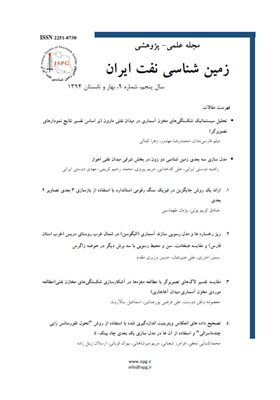تصحيح داده هاي انعکاس ويترينيت اندازهگيري شده با استفاده از روش "تحول فلورسانس زايي چندماسرالي" و استفاده از آن ها در مدل سازي يک بعدي چاه بينک-4
محورهای موضوعی :محمد کسائی نجفی 1 , فرامرز شعبانی 2 , مریم میرشاهانی 3 , بیوک قربانی 4 , ارسلان زینل زاده 5
1 - شرکت ملی نفت ایران
2 - شرکت ملی نفت ایران
3 - شرکت ملی نفت ایران
4 - شرکت ملی نفت
5 - شرکت ملی نفت ایران
کلید واژه: بلوغ حرارتي انعکاس ويترينيت تضعيف انعکاس فلورسانسي زايي ماسرال هاي چندگانه(فم) چاه بينک-4 ,
چکیده مقاله :
در مطالعات ژئوشيميايي اکتشاف نفت، انعکاس ماسرال هاي تشکيل دهنده کروژن، به ويژه انعکاس ويترينيت، يکي از مهم ترين شاخص-هاي تعيين بلوغ حرارتي مواد آلي و تشکيل نفت و گاز است. علي رغم اينکه انعکاس ويترينيت به طور معمول با افزايش عمق دفن شدگي رسوبات افزايش مي يابد، خيلي اوقات مهندسين اكتشاف هنگام مدل سازي بلوغ حرارتي، که با استفاده از مقادير انعکاس ويترينيت اندازه گيري شده با ميکروسکوپ پتروگرافي آلي فتومتردار کاليبره مي شود، با مشکل مواجه مي شوند. اين مشکل به سبب وجود ماسرال هاي مختلف و تضعيف انعکاس ويترينيت (ساپرشن) به وجود مي آيد. براي حل مشکل تضعيف انعکاس ويترينيت دانشمندان استراليايي با استفاده از ميکروسکوپ رامان ليزري يك روش چندپارامتري به نام "تحول فلورسانس زايي چندماسرالي" را توسعه دادند که به منظور اختصار آن را فَم ناميدند. در اين مقاله، به منظور آشنا نمودن خوانندگان هدف با روش فم و نحوه استفاده از داده هاي حاصل از آن، ابتدا اين روش به طور خلاصه معرفي شده است. سپس براي كاليبره كردن مدل يك بعدي ارائه شده براي چاه بينك-4 از داده هاي انعكاس ويترينيت اندازه گيري شده و داده هاي انعكاس به دست آمده از به كارگيري روش فم استفاده شده است. به منظور تبيين اهميت تصحيح داده هاي انعکاس ويترينيت به عنوان معمول ترين و مهم ترين پارامتر جهت کاليبراسيون مدل هاي حرارتي و مشخص کردن زمان و عمق زايش هيدروکربن از سنگ هاي منشأ پابده، گورپي، کژدمي و گدوان، داده هاي انعکاس ويترينيت و فم در مدل سازي يک بعدي چاه بينک-4 به کار برده شده و نتايج حاصل باهم مقايسه شده اند. تفاوت هاي زياد نتايج حاصل از کاليبراسيون مدل بلوغ با استفاده از داده هاي انعکاس ويترينيت معادل حاصل از روش فم با داده هاي انعکاس اندازه گيري شده در روغن امرسيون، از نظر ميزان پختگي، درصد تبديل ماده آلي، گستره توليد و مقدار رانش نفت، با استفاده از نمودارهاي حاصل از مدل سازي نشان داده شده اند. اين تفاوت ها در استراتژي هاي اکتشاف بسيار تعيين کننده هستند. کلمات کليدي: بلوغ حرارتي، انعکاس ويترينيت، تضعيف انعکاس، فلورسانسي زايي ماسرال هاي چندگانه(فم)، چاه بينک-4.
Reflectance of maceral constituents of kerogens, particularly vitrinite (Ro%), commonly used in petroleum exploration, is a very important indicator for determining degree of thermal maturity and investigating status of hydrocarbon generation. Although in vitrinite reflectance profiles maturity generally increases with increasing depth of burial, basin modelers often experience problems when modeling thermal maturity using vitrinite reflectance data measured by using reflected light- photometer microscopes. The problem of reduced vitrinite reflectance mainly arises due to reflectance suppression in vitrintes. By using the laser Raman microprobe, a new multi-parameter technique called "Fluorescence Alteration of Multiple Macerals (FAMM)" was developed by Australian scientists to solve these problems. In this study, data obtained by application of this method were used to correct suppressed vitrinite reflectance values. In order to examine and demonstrate the extent of suppression effect on modeling results, maturity profile constructed by one-dimensional modeling of Well Binak-4 was calibrated using conventional measured vitrinite reflectance (Ro%) and FAMM equivalent vitrinite reflectance (EqVR) data and results were compared with present time measured well temperatures. The crucial differences in maturation, transformation ratio, hydrocarbon generation and expulsion resulted from application of these two type data as calibration parameters are discussed and demonstrated using relevant diagrams.
#HUNT, J.M., 1996, Petroleum Geochemistry and Geology. 2nd Edition. W.H. Freeman and Company, New York, 332
KALKREUTHA, W., SHERWOOD, N., CIOCCARIA, G., CORREˆA DA SILVAA, Z., SILVAA, M., ZHONGC, N., and ZUFAD, L., 2004, The application of (Fluorescence Alteration of Multiple Macerals) analyses for evaluating rank of Parana´ Basin coals, Brazil: International Journal of Coal Geology, 57, 167– 185#
LEWAN, M.D., 1993, Identifying and understanding suppressed vitrinite reflectance through hydrous pyrolysis experiments (abstract): TSOP Abstracts and Program, 10, 1-3#
PRICE, L.C., and BARKER, C.E., 1985, Suppression of vitrinite reflectance in amorphous rich kerogen; a major unrecognized problem: Journal of Petroleum Geology, 8, 59-84#
SEEWALD J.S., and EGLINTON, T.I., 1999, Laboratory Simulations of Organic Matter Thermal Maturation. The Encyclopedia of Geochemistry. Earth Science Encyclopedia Series (C.P. Marshall, ed.) Kluwer, The Netherlands#
TEICHMULLER, M., and OTTENJAN, K., 1977, Art und Diagenese von Liptiniten und lipoiden Stoffen in einem Erdolmuttergestein auf Grund fluorescenzmikroskopischer Untersuchungen: Erdöl und Kohle, 30, 387–398#
WILKINS, R.W.T., WILMSHURST, J.R., RUSSELL, N.J., HLADKY, J, ELLACOTT, M.V., and BUCKINGHAM, C.P., 1992, Fluorescence alteration and the suppression of vitrinite reflectance: Organic Geochemistry, 18, 629-640#
WILKINS, R.W.T., RUSSELL, N.J., and ELLACOTT, M.V., 1994, Fluorescence alteration and thermal maturity modeling of Carnarvon Basin wells. In PURCELL, P.G., and PURECELL, R.R., (Eds.). The sedimentary basin of Western Australia: Proceedings of the Petroleum Exploration Society of Australia Symposium, Perth, 415-432#
WILKINS, R.W.T., WILMSHURST, J.R., HLADKY, G., ELLACOTT, M.V., and BUCKINGHAM, C.P., 1995, Should fluorescence alteration replace vitrinite reflectance as a major tool for thermal maturity determination in oil exploration: Organic Geochemistry, 22, 191-209#
WILKINS, R.W.T., BUCKINGHAM, C.P., SHERWOOD, N., RUSSELL, N.J., FAIZ, M., and KURUSINGAL, J., 1998, The current status of the FAMM thermal maturity technique for petroleum exploration in Australia: Australian Petroleum Production and Exploration Association Journal, 38, 421-437#
WILKINS, R.W.T., DIESSEL, C.F.K., and BUCKINGHAM, C.P., 2002, Comparison of two petrographic methods for determining the degree of anomalous vitrinite reflectance: International Journal of Coal Geology, 52, 45– 62#


